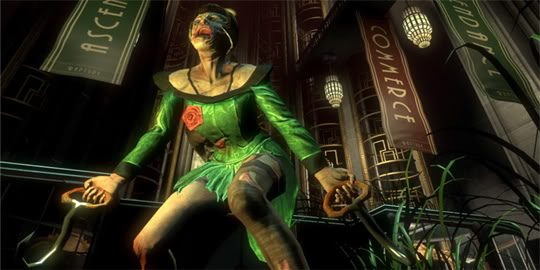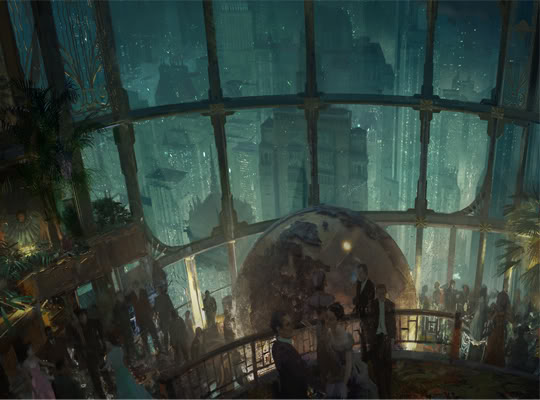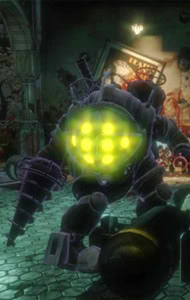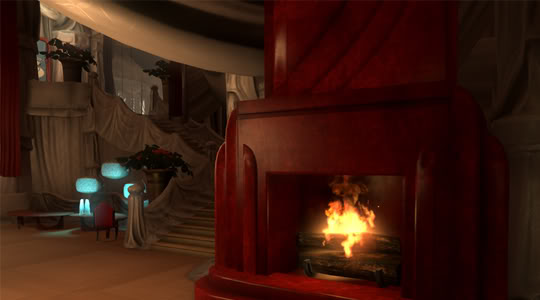This post has not been edited by the GamesBeat staff. Opinions by GamesBeat community writers do not necessarily reflect those of the staff.
Warning: This article contains plot spoilers for BioShock and BioShock 2.

There’s a moment that encapsulates the experience of BioShock, the story of a wondrous city’s rise and fall, but it’s not one you’ll likely first remember. In a trivial moment during the journey, Atlas, the player’s guide, ponders aloud about the now-deformed and insane denizens of ruinous Rapture: “Why do they wear those masks? Maybe there's a part of them that remembers how they used to be, how they used to look. And they're ashamed."
As gamers, we’re rarely tested with problems for which there are no answers; every puzzle has its solution. BioShock breaks that rule – Rapture is a world we can never save. Our story does not begin when its does. The city that was exists just outside of our reach, revealed to us in old audiotapes and environmental clues. We come to care for the people that once lived here, without ever really meeting them.

But it can never again be the thing that it was. That Rapture was betrayed, and the one we’re left to explore leaves us with a disquieting sense of impotency. Its murderous residents are still human – and for all their madness, they still experience fear, anger, joy, and heartbreak. Just what are the moral implications of killing an enemy who feels pain before the end? Our task is saving what we can, knowing it will never be enough, and knowing we inflicted agony on others just for our own survival. There is no victory in winning.
 Rapture shares its tale minimally, often without our realizing it. We learn in-game specifically how the hulking Big Daddies are produced, but their design alone speaks abundantly. We feel in their quaking movements someting heavy and powerful. We fear in their frantic howls something feral and wild. We hear in their labored cries something recognizable, almost human. Examples like this are scattered throughout the city, and they inform its atmosphere as much as any dialogue or plot device.
Rapture shares its tale minimally, often without our realizing it. We learn in-game specifically how the hulking Big Daddies are produced, but their design alone speaks abundantly. We feel in their quaking movements someting heavy and powerful. We fear in their frantic howls something feral and wild. We hear in their labored cries something recognizable, almost human. Examples like this are scattered throughout the city, and they inform its atmosphere as much as any dialogue or plot device.
If there’s an underlying failing, however, it’s the contrast between what Rapture shows us and what the narrative and game mechanics ultimately present us. BioShock is troubling in that it starts difficult and ends easy – it’s a horror story that abandons horror. As our arsenals expand, fearful menaces become incessant nuisances. The anxiety over what lurks around each corner eventually dissipates.
Rapture instills in us early on a desperate hunger for resources – we search every nook for one more first aid kit, a few more bullets. But then it overcompensates – items and money become ubiquitous, and our habitual instinct feels at odds with the glut of resources now available to us. The difficulty ceases to reflect the danger this place should represent.
Rapture was always a caricature of sorts, with unbridled, tongue-in-cheek spirit brimming over its loudspeakers and artwork, but it becomes cartoonish by the end. Like the ridiculous final image of Atlas, we find ourselves at BioShock’s conclusion an abomination of our earlier selves, removed from the tension that once carried us.
The sequel only exacerbates matters. Sophia Lamb’s new Rapture is riddled with manic graffiti glorifying a shift in politics and philosophy away from the era of Andrew Ryan and Atlas. And yet, for all the signs of a new order, nothing in our enemies shows evidence of this turn of events. Lamb’s lackeys are similar to those of her predecessors in almost every way. This is a narrative inconsistent with its setting.

These conflicts matter; they betray the authenticity of the place we’ve been sold. And so when the story tells us something that our environment doesn’t reflect, it makes us feel cheated. Suddenly, Rapture is no longer genuine. And if this place and its people aren’t real, why should we care?
To understand whether Rapture can ever be properly revisited, we have to grasp this detail. BioShock isn’t about plot twists – it’s about a world that allows us to feel something authentically human. When it stops doing that – when Rapture becomes untrue to itself – that’s when its premise becomes tired and overdrawn.
The penultimate level of BioShock 2 illustrates this, as we suddenly see the city through the eyes of a warped Little Sister. The world changes before us – darkened corridors are lit anew, draping the waterlogged browns and grays of Rapture’s fading architecture with luscious hues of red and beige – and we finally understand why these children behave so cheerily in the midst of such death and decay.

Over two full games, we came to know two Raptures – one that was and one that is. This setting shift offers a third: the city its inhabitants’ tortured minds see. It permits us a brief moment of empathy, to see someone else’s world, and this defines storytelling in BioShock at its best. Looking out through an open window across the towering ‘skyline’ of Rapture, I'm left wondering what other experiences are still out there to be shared.
But it doesn’t matter if Rapture ever appears again. Its legacy is as an example of how tone and atmosphere can quietly tell a story. In that respect, it exists in our collective gaming consciousness alongside a host of other lost worlds: the ruins of Ilos in Mass Effect, the windswept wastelands of Fallout, the lonely, neon streets of Halo 3: ODST’s New Mombasa, and every ancient citadel of Metroid Prime. Rapture is not a physical location. Rather, it is the longing we feel in every place where we discover something forgotten and abandoned – and fewer themes are more fundamental to gaming.
